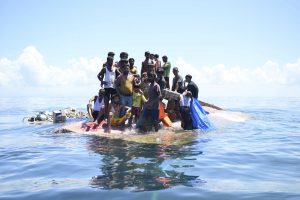An Indonesian search and rescue ship yesterday rescued dozens of Rohingya refugees from a capsized wooden boat off the coast of Aceh, underscoring the peril of the ocean journeys from Bangladesh.
According to a report from The Associated Press, which had a photographer aboard the Indonesian vessel, 59 people were saved by the search and rescue ship yesterday afternoon, and an additional 10 were picked up by local fishing boats.
The AP quoted a rescue officer as saying that the vessel had “managed to evacuate all 69 people and no one stated that anyone had died.” A further six Rohingya were rescued by private fishing boats well before the official rescue mission arrived on the scene, bringing the total of those rescued to 75.
The AP interviewed one 17-year-old survivor, who said that those aboard had departed from the Kutupalong refugee camp in Cox’s Bazar in southeastern Bangladesh, where around 1 million Rohingya have languished since a violent expulsion campaign launched by the Myanmar military in August 2017.
According to the survivor, the boat began to flounder three days prior to its rescue, before capsizing on Wednesday. An official search and rescue team set off from Banda Aceh, the capital of Aceh on the western tip of Sumatra, on Wednesday evening. When rescuers finally located the boat at midday yesterday, they found the refugees perched on its hull, desperate for help. As the agency reported, “Men, women, and children, weak and soaked from the night’s rain, wept as the rescue operation got underway and people were taken aboard a rubber dinghy to the rescue boat.”
Boats have been issuing forth from Bangladesh and Rakhine State in Myanmar for more than a decade, but have increased markedly since the Myanmar military’s 2017 “clearance operation,” which drove more than 700,000 Rohingya civilians from Rakhine State into Bangladesh. Most are seeking sanctuary in other parts of Southeast Asia, particularly in Muslim-majority Malaysia and Indonesia, despite facing an increasingly hostile reception in both nations.
This week’s near-disaster off the coast of Aceh underscores the dangers inherent in the journeys, which can only be undertaken for a few months per year but even then remain extremely perilous. Last year, 569 people died or went missing while crossing the Bay of Bengal and Andaman Sea, the highest death toll since 2014, according to UNHCR, the United Nations refugee agency. This translated into around one in eight of those undertaking the ocean crossings.
In announcing the dire statistics, UNHCR spokesperson Matthew Saltmarsh described the Andaman Sea and Bay of Bengal as “one of the deadliest stretches of water in the world.”
The fact that people would prefer to take this chance than remain in the refugee camps of Cox’s Bazar reflects the widespread crime and lack of prospects in the camps, and the vanishingly small chance of returning to their former homes in Rakhine State. Indeed, the number attempting such crossings has increased markedly over the past few years. Last year, nearly 4,500 Rohingya — two-thirds of them women and children — embarked on sea journeys, most from the refugee camps in Bangladesh. This came after an estimated 3,545 people undertook perilous sea voyages in 2022, itself a fivefold increase on 2021, when around 700 people made similar journeys.
These numbers appear set to increase. According to UNHCR, the “dignified and sustainable return [of refugees] to Myanmar remains the primary solution” to the refugee crisis in Bangladesh. But as the International Crisis Group (ICG) stated in a report released in November, the prospect of this happening any time soon is slim, given the ongoing civil war inside Myanmar and the broad lack of trust that most refugees have toward the military regime in Naypyidaw.
At the same time, conditions in the camps of Cox’s Bazar are only worsening, with the ICG identifying waning international support, a purposefully punitive Bangladeshi policy toward Rohingya refugees, and growing violence and criminal activity, as the main factors. For increasing numbers of Rohingya, all of this has made perilous ocean journeys seem like the best available option.

































